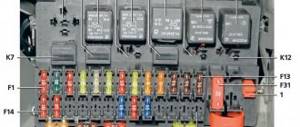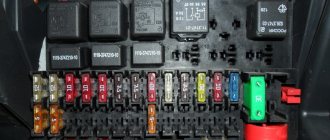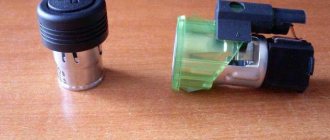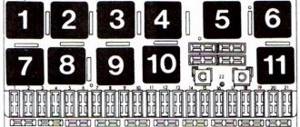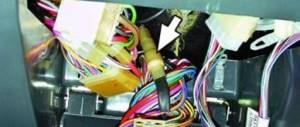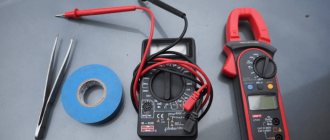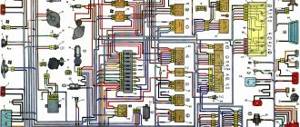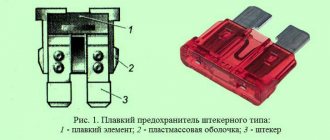Initially, the cigarette lighter was an element whose sole purpose was to be able to light a tobacco product with one hand, without being distracted from driving the vehicle. Since it is usually located in the driver’s direct line of sight, there are no problems with its quick removal. And to activate the cigarette lighter you don’t have to make any unnecessary movements - just push it down, and the reverse clicking will signal that the coil has already heated up and you can use it for its intended (and not only) purpose.
With the advent of lighters with equally compact dimensions, the relevance of the cigarette lighter temporarily fell, but the development of microelectronics returned it to its former popularity. Many mobile gadgets, from navigators to watches, which require 12 V power supply, are equipped with a plug compatible with the cigarette lighter socket, which allows it to be used to operate a variety of devices. However, operating voltage and current consumption are two different things, and there are often cases when, due to high load, the fuse responsible for the operation of the cigarette lighter blows out. Replacing a fuse is not a difficult task if you know where it is located. But this is precisely the main problem, since many domestic car owners are not very versed in the symbols and diagrams that are supplied with all cars.
Why does a fuse blow?
The purpose of any electrical fuse is to protect the connected consumer from current loads exceeding the permissible (established by the manufacturer) values. A car fuse is a small plastic part, inside of which there is a wire with two terminals designed to connect the fuse to a specific section of the electrical circuit. The principle of operation of the fuse responsible for the cigarette lighter is no different from all its other brothers: if the current strength exceeds the permissible values (constant for a PP of a particular rating), it begins to heat up to such an extent that its middle section melts. The chain breaks, and the consumer remains unharmed, since the fuse took the entire blow, sacrificing his life.
This approach is more than justified - the cost of the fuse is cheap, it can be replaced in a matter of seconds.
Since the on-board electrical network of a modern vehicle includes more than a dozen consumers, the number of fuses is also large, and some of them protect not one, but several electrical devices. They all differ in denomination, designed for a certain value. In particular, the cigarette lighter fuse rating in most cases is 15A.
In addition to the current value, PPs differ in size and color. Coloring them should, in theory, make it easier for motorists to navigate, but few of them can say with certainty what the fuse is intended for, judging only by its appearance. Rather, this “feature” turned out to be useful for auto electricians, but not for mere mortals.
What makes the situation even more confusing is the use of different automakers’ own color schemes, which do not always coincide.
So if, for example, your cigarette lighter fuse has blown, before replacing it, it is better to study the user manual in order to avoid making a mistake that could be fatal.
Here is the marking of the fuses located in the block depending on their standard size (in ascending order):
- Mini (the smallest);
- Medium (medium-sized);
- Maxi (large);
- JCase (cartridge type);
- PAL (also in a cartridge type shell);
Note that it will not be possible to replace a blown cigarette lighter fuse with a PCB of a different type with the same rating, since it will not have the same shape of the socket - this must be taken into account when going to a car shop. Having told the seller how many amperes the cigarette lighter fuse of your car is, you will receive a perplexed face in response - the value alone is not enough.
The burnout of an automobile PP, as already noted, is caused by only one reason - an abrupt excess of the rated current value. But if we talk about why such situations arise, the reasons may be different. Typically this is the use of devices whose electrical parameters do not correspond to the characteristics of the on-board network or the fuse rating. As for the cigarette lighter specifically, a factor such as the consumer’s continuous operation time comes into play: for a cigarette lighter it is about 10 seconds, and if you connect a car vacuum cleaner, it can work hard for an hour. However, the cigarette lighter itself can be activated almost continuously, and this can also be an unbearable load on the fuse.
And since most new electrical appliances are connected specifically to the cigarette lighter socket, you need to clearly understand what load this device is designed for.
But even in cases where the electrical characteristics of the connected device fully correspond to the parameters of the on-board electrical network, this does not mean that the risk of failure of the PP is zero. Voltage surges have been, are and will be, and it is impossible to predict them, since their activator can even be a purely external factor - for example, driving near a powerful source of electromagnetic waves. However, the most common reason for a cigarette lighter fuse to blow is the connection of heating devices - an electric kettle or a boiler, which require high power for their operation, and for a long period of time. So if you are a big fan of hot drinks, please stock up on a set of PP - you will definitely need them.
But the use of less load-demanding, but low-quality electronic devices (for example, DVRs assembled from unknown places) can also cause fuse failure.
Which fuse is for the cigarette lighter?
A device such as a cigarette lighter often fails, or rather not the device itself, but its fuse, which protects against excess voltage reaching (in this case) the cigarette lighter.
Cigarette lighter for Niva Chevrolet
The fuse blows due to, for example, the connection of a closed electric pump. It happened once that an acquaintance bought an electric car pump at a local auto parts store, brought it to work and decided to try pumping up the tires. After connecting to the cigarette lighter, the fuse immediately blew out. Then, one person decided to try it on his car, and the fuse on his car also blew. We started reading the book from the pump, it was written: “Made in the USA” (with the letter Ш:)). We laughed and he took us to a replacement. It turned out the pump was shorted.
The cigarette lighter fuse mainly burns out from connecting other devices, now there are a great variety of them: DVRs, radar detectors, FM modulators, chargers, etc. The cause of a temporary malfunction of the cigarette lighter (burnt-out PP) is a poor-quality electronic device due to which the voltage jumps. It is also possible that the cigarette lighter itself may burn out, and not just the fuse.
Connected laptops, electric kettles, external radios and radios lead to the fuse burning even faster, since these devices have their own voltage converters.
Depending on the make and model of the car, the fuse may be common to the radio, or may be specific to the cigarette lighter.
Where to look for the cigarette lighter fuse
It is quite simple to make sure that this particular cigarette lighter has burned out - you just need to connect several known working devices, including the standard cigarette lighter. If they all show no signs of life, the reason is precisely the PP. But where the cigarette lighter fuse is located is a task with many unknowns, especially if you have never changed it before.
Usually, all car fuses are sorted into blocks: even the VAZ classic has two of them: one in the passenger compartment, the other in the engine compartment. They are grouped in order to combine in one block PCBs that serve devices with similar characteristics or locations, and even entire lines. Externally, it is, as a rule, a flat box with a lid with latches, which can be located anywhere, including sometimes very unexpected places:
- in the engine compartment (most often, not far from the windshield, where powerful electrical wiring harnesses are concentrated);
- in the cabin (standard - under the dashboard, but there are boxes behind the trim);
- in the luggage compartment (this method is practiced by some foreign automakers);
- behind the glove box.
Ancient cars were not so power-hungry in terms of electrical appliances, so they were equipped with compact, narrow fuse blocks that did not take up much space. Today, appetites have increased many times over, which is why boxes for PP have much larger sizes.
It is impossible to determine which fuse is responsible for the cigarette lighter purely externally, since the shape of many car fuses is the same. If for various reasons you are unable to see a hint somewhere, you should exclude from consideration all PCBs with a large or small rating - the cigarette lighter socket is designed for 10 or 15 Amps. On the cover of the blocks on the inside there is usually a diagram of the location of the fuses, even with an indication of their belonging to a specific electrical circuit, but the markings there are unclear - a non-expert in the abbreviation is unlikely to understand it; we note that the fuse we are interested in may be marked “SIG”, but not necessarily. If attempts to calculate the location of the PP according to the diagram failed, then, unless you are a psychic, it is best to resort to reading the instructions (user manual), where everything is described clearly and unambiguously. However, if you have a tester at hand, you can try to achieve the desired result by ringing, but this, firstly, is long and tedious, and secondly, without obtaining a guaranteed result. In addition, the location of the box can be so inconvenient that any ringing is out of the question.
So we return to where we started - to the manual for this car model. But even here, unpleasant surprises may lurk - if you have a manual from a somewhat outdated or pre-restyling modification - in this case there is a possibility of some differences, but in any case minor. Moreover, automakers try not to change the standard locations for placing PP units, so within the same brand you can safely look for them in familiar places.
Let's start looking at where the cigarette lighter fuse is located for popular brands/models of passenger cars in Russia:
- on a VAZ 2108/2109 you can find the fuse box, which contains the element we are interested in, in the engine compartment, right next to the windshield on the glove compartment side. If the model is an old model, then the required PP has number 7, less often – 12. On cars manufactured after 2000, the cigarette lighter fuse is most often marked F4, but there is also an option with F10. If the exact location is unknown, it’s not a big deal, since you only have two options, which can be checked by basic brute force;
- on VAZ models 2110/2112/2111, the required auto fuse is located in the mounting block and is designated as F18. At the same time, it has a fairly impressive rating - 25 A. This, in general, is a rarity, allowing you to connect a large number of powerful electrical appliances to the cigarette lighter. The mounting block is located under the instrument panel to the left of the steering wheel. Don’t get confused, because on these models the other block, which contains both fuses and relays, is located on the right side, and also under the dashboard;
- in the Samara 2 family with models 2113/2114/2115, which are like improved versions of the “eight” and “nine”, the location of the main unit is different - also in the engine compartment, but next to the battery. Much less common is a modification in which our PP should be found in the block located under the dashboard. Most fuses on these models are made in the blade type, which is very common. What’s great is that the designers finally thought of placing a fairly informative diagram on the cover of the mounting block that does not allow it to be interpreted ambiguously. As a rule, PPP is labeled F7;
- The Lada Priora power supply is mounted in the cabin, on the left under the main panel. To gain access to the fuses, you need to unclip the cover. The cigarette lighter fuse for this model, regardless of modifications, is located in one place (position F13), which does not allow for discrepancies. The fuse rating is 15 A. Such a small value can be explained by the fact that this PCB has a line dedicated only to the cigarette lighter; it does not serve other circuits, like many other brothers;
- on the Lada Kalina MB, on which the cigarette lighter fuse is located, is mounted in the lower left part of the dashboard, to be more precise - behind the panel of external lighting devices. Here again, there will be no need to guess in the absence of a user manual, since the PP is always marked F20. But the block itself was produced in two versions, designed to accommodate 31 or 26 relays/fuses;
Fuse box - The BPP on the Lada Granta should be looked for in the cabin, in a place standard for many VAZ models - on the left under the dashboard. Here, the block cover on the reverse side is also equipped with a detailed diagram that describes the PP numbers. In particular, the fuse that protects the cigarette lighter from overloads is numbered F20, being Kalina’s successor in this regard. The rating here is also low - 15 A, so when connecting new devices to the socket you need to be careful, otherwise you won’t be able to do without a pack of spare devices. The fact is that on the same circuit there are such consumers as the electric trunk lock, the “beep” (sound signal), as well as the diagnostic connector, and if all devices are used at the same time, the fuse may become “offended”;
- at the Ford Focus, the designers placed the blocks in several places. So, in the first generation Ford Focus, one of the boxes is mounted on the left side under the steering wheel, in the second/third generation models - under the engine compartment lid, near the windshield on the steering wheel side. There is a layout diagram for the PP, the cigarette lighter fuse is designated here as number 109, and its rating is standard for most foreign cars - 20 A, regardless of modification;
- The fuse box of the Renault Logan is placed in the cabin, but a little non-standardly - at the end of the instrument panel, which, in principle, does not play a special role. However, on the second generation Logan, you should look for auto fuses already under the hood: the box is located near the battery. The location is also different for some reason - F38 for the first-born and F33 for the younger representative of the brand. Note that the Renault Logan has one of the lowest ratings - only 10 A. And although the cigarette lighter is serviced separately, this is still not enough for most of today's voracious consumers. The second generation has a better situation - 15 A;
- since the Volkswagen Polo has several modifications, the location of the mounting block for this model has two placement options: inside the car under the steering wheel (block B, the design is built into the panel) or in the compartment for the power unit (two power supplies are located here, designated by the letters A and C) . The marking of the positions of the cigarette lighter fuse is also different with the same rating of 15 A: the first generation has BS42, the Polo 3 has F22 (with a rating of 10 A), the fourth generation has F49, the Polo 5 has the cigarette lighter fuse number F. Why are the Germans, Those who love order have made such a mistake? Differences in the layout are due to the peculiarities of the production technology of cars of a given brand. The Germans use a flexible scheme that allows them to change many parameters of the car without any problems;
- The fuse box for the Chevrolet Cruze is looked for under the hood, on the driver's side, near the niche. The cigarette lighter protection is provided by a yellow fuse (which means that the nominal value is 20 A) and has a serial number of 6. It is not difficult to find out about this if you look under the cover of the mounting block, where there is a detailed schematic description of all PCBs;
- Opel Astra is one of the few cars where the fuse box is placed in the luggage compartment. True, mounting blocks are also available in standard places - under the hood and inside the car. In this case, the element we are interested in is located either in the trunk (model H, rating 15 A, serial number - 29), or in the cabin (twenty-amp model F No. F20 or model J with the same rating, but number 6);
- Subaru Forester designers placed a blue plastic fuse/relay box in the driver's side powertrain compartment. You can find the 15 A cigarette lighter fuse at position F4.
Cigarette lighter fuse: why is it needed and where is it located?
The main purpose of a cigarette lighter on a car is to ensure traffic safety. Such a device is located in the driver’s field of vision, so if he wants to light a cigarette, he only needs one hand, without being distracted at all from the situation on the road. Such a device starts from one movement.
Thanks to the presence of such a convenient device in the car, situations of searching for a lighter in your pockets and other actions distracting from the situation on the road are eliminated. Recently, the cigarette lighter socket has begun to be used not only for this purpose, but also for connecting various devices to the on-board network.
Due to the varying load and duration of operation of such devices, a fuse may blow over time. This does not pose a serious problem for the motorist, and replacing it does not cause any difficulties.
The only thing that motorists sometimes encounter is the problem of finding the location of the fuse, which is responsible for the operation of the cigarette lighter. This material will describe this problem in detail.
Which fuse is responsible for the cigarette lighter: the reasons for its burnout
The car fuse itself is a part with two contacts that are connected by a wire. When the current increases above the rated value, this fuse begins to heat up and then melts. In this case, the connection between the consumer and the on-board network is completely terminated.
The main reason for fuse failure is precisely the excess of the calculated current value. In practice, this situation arises, as a rule, due to the fact that most devices simply do not correspond to the on-board network or are of poor quality. Such devices require a high current value, which always exceeds the rating of the PP.
Also, not the last factor in this matter is the value and operating time. The operating cycle of the cigarette lighter is 10 seconds. Accordingly, when using, for example, a vacuum cleaner, this can take even an hour.
For this reason, the use of unknown and low-quality devices that motorists connect to the socket often pose a potential threat to the fuse.
Where is it located and how to find it?
The cigarette lighter fuse is located in the corresponding block, that is, in the node where all the PPs of different lines and systems of the vehicle are collected. It is a block plastic box that can be located in different parts of the car:
- In the engine compartment;
- Under the dashboard or interior trim;
- Behind the glove box;
- In the luggage compartment.
It is very difficult to distinguish the cigarette lighter fuse from other fuses. You can try to turn off, for example, all low-ampere and high-amp devices, because the cigarette lighter fuse is usually set to 10-15 A. You can also study the fuse layout on the fuse box cover.
Some brands of cars provide this. If it is impossible to make out the information on the fuse box cover, then you need to use the instructions. You can try to determine the PP using the ringing method.
But this method of determining the fuse takes a lot of time and does not provide any guarantee at all.
How to replace the cigarette lighter fuse will be described in more detail in this video:
Source: https://automend.ru/articles/predohranitel-prikurivatelya-zachem-nuzhen-i-gde-nahoditsya/
How to replace the cigarette lighter fuse
Each driver should carefully study how many and what kind of software are present in his car. Of course, you don’t need to carry the same number of spare fuses with you, but having a solid supply of all ratings (2-4 pieces each) is vital. Since they are inexpensive and take up even less space, there will be no problems with storing them. But looking for them among other trash can be a much more difficult task. Remember that such a need may arise at any time, and if everything is not in order with the electrical part of the car, then more than one replacement may be required before the problem is eliminated.
This operation must be performed with the ignition turned off; for insurance purposes, it is better to remove the key altogether. Don't forget to disconnect the negative terminal of the battery. Further actions are extremely simple - open the lid (the clamping mechanism may be different), find our part, and pull it out using tweezers. It is advisable to use branded tweezers; they are usually hidden on the lid of the unit. Do not try to pull out the fuse with tweezers that are too thin. If it is not nearby, then you will probably find pliers - you can also use them carefully. You need to install a cigarette lighter fuse to replace the burned one with the same one. If you don’t have the right one at hand, you’ll have to do without using the device connected to the cigarette lighter until you buy the one you need. Many people solve the problem by installing “bugs” in the form of a wire or a paper clip - we strongly recommend that you abandon this option, since this can have serious consequences for both the rest of the electronics and the car (there are many cases when such amateur activities ended in a fire).
Rarely, there are situations when the PP has melted and does not want to be removed. It is unacceptable to use force in such cases - you risk breaking the entire panel. Try to carefully loosen the body. With enough persistence and perseverance, sooner or later the fuse will be removed. As a last resort, you can try to pry it off with the tip of a screwdriver, knife or other sharp object. If you use brute force, you can damage the seats, which will definitely create a new headache for you.
But such problems are extremely rare, so replacing the PP is a simple operation that even a child can cope with (figuratively speaking, do not consider it a guide to action). It is much more important to find out why the fuse failed and which device is responsible for the emergency. To do this, you may have to take measurements with a tester, and if a source of increased power is found, it is better not to use it. In any case, you can find a suitable replacement by purchasing a similar device, but consuming less power.
